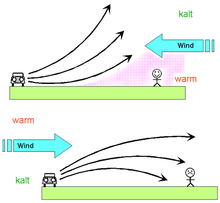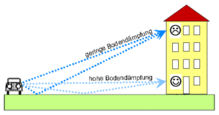Sound propagation
With sound propagation is called the wave phenomenon that the propagation of a stress disorder, as well as the transmission of sound pressure changes in an acoustic field leads. An elastic medium is required for the propagation of sound ; in an ideal vacuum , no sound transmission is possible. The movement of the sound is uniform. In gases and liquids, the sound spreads as a longitudinal wave , in solid media also in the form of transverse waves and bending waves . The speed of propagation is called the speed of sound .
Sound spreads in a homogeneous sound-conducting medium in all directions symmetrically away from the exciter (i.e. the sound source ). If the pathogen moves in the medium (or if the medium moves around the pathogen, which, viewed from the medium, equates to a movement of the pathogen in the medium), the Doppler effect occurs. This also occurs when the observer (listener) moves in the medium (or accordingly the medium around the observer).
If several sound waves meet, they overlap undisturbed at low amplitudes. At very low frequencies and large amplitudes, locally limited temperature deviations occur, which, because of the temperature dependence of the speed of sound, leads to non-linear effects.
The properties of the sound wave change at the interfaces between different media. In particular, absorption and reflection (for example on walls) as well as refraction occur. The sound is practically completely reflected at the metal / air interface.
Propagation of sound in the atmosphere
If sound propagates through the atmosphere (e.g. traffic noise ), it is influenced by the meteorological conditions and the acoustic properties ( acoustic impedance ) of the ground.
Air absorption
Some of the sound energy is absorbed through molecular friction and other molecular properties as it travels through the atmosphere. The degree of air absorption , which is usually given in dB / 100 m, depends on the air temperature and humidity . Higher frequencies are absorbed much more strongly than lower frequencies. A recognized calculation method for the degree of air absorption is specified in ISO 9613-1. Atmospheric absorption coefficient translates as the atmospheric absorption coefficient .
| Attenuation in dB / km at | ||||||||
| temperature | humidity | 125 Hz | 250 Hz | 500 Hz | 1000 Hz | 2000 Hz | 4000 Hz | 8000 Hz |
|---|---|---|---|---|---|---|---|---|
| 10 ° | 70% | 0.4 | 1.0 | 1.9 | 3.7 | 9.7 | 32.8 | 117 |
| 20 ° | 70% | 0.3 | 1.1 | 2.8 | 5.0 | 9.0 | 22.9 | 76.6 |
Refraction
Like any form of wave, sound waves also change their direction when the speed of propagation for different wave trains is different.
Analogous to light rays that are deflected (" refracted ") in the direction of the area with lower propagation speed (the optically denser medium), sound waves are also refracted in the direction of the area with lower sound speed.
Such areas are i. A. Meteorological reasons, especially due to the microclimate along the way. Two weather conditions - in principle independent in this context - are decisive here: air temperature and wind direction.
If the temperature decreases with altitude, the speed of sound also decreases upwards and the sound is refracted upwards. In such situations, from a certain distance (with sound sources close to the ground from around 200 m) an acoustic shadow zone with reduced audibility forms. This is mainly the case during the day because of the warming of the soil by solar radiation. If, on the other hand, the temperature rises with altitude ( inversion ), this leads to a downward refraction of the sound waves and possibly multiple reflections on the ground. The result is good audibility over great distances. This is especially the case at night.
Even wind causes spatial differences in the speed of sound: As the wind speed increases generally with altitude, the sound in wind direction down is broken down, so it is heard better over long distances. Conversely, sound propagation against the wind by refraction upwards leads to a shadow zone and reduced audibility.
The weather-related fluctuation of the sound level at a distance of 500 to 1000 m from a constant sound source can be between 20 and 30 dB.
scattering
Some of the sound energy is scattered in the atmosphere when it passes through turbulence . Scattering is a mechanism by which sound energy can enter shadow areas, such as upward refraction. Sound waves are mainly scattered when their wavelength has the order of magnitude of the expansion of the turbulence elements (eddies).
Diffraction
Diffraction is another mechanism with which sound energy can penetrate into shadow areas, for example into shaded areas behind a building or a noise barrier . Long, low-frequency waves are bent more strongly than short, high-frequency waves.
Reflection on the ground
If sound waves hit the ground, they are reflected. Depending on the acoustic properties of the floor ( soft sound = low characteristic acoustic impedance or hard sound = high impedance), more or less sound energy is absorbed in the floor or the reflected wave is phase-shifted so that the floor has a more or less sound-absorbing effect. Loose, porous soil and freshly fallen snow are sound-soft and therefore have a strong dampening effect, while compacted soil, asphalt or concrete are hard-sound and therefore have little damping. A high level of floor attenuation is achieved above all with sound-soft floors and shallow sound incidence (source and receiver close to the floor). On hard floors, the sound is superimposed (= added) and reflected, which, depending on the angle and position of the listener, leads to an amplification or weakening (or even extinction) of individual frequency components. See comb filter.
Sonic shadows
A sound shadowing or a sound shadow occurs when there are obstacles on the direct sound path from the sound source to the listener or microphone.
Speed of propagation
| T in ° C | c in m / s | t in ms |
|---|---|---|
| 35 | 352.17 | 2.840 |
| 30th | 349.29 | 2.864 |
| 25th | 346.39 | 2,888 |
| 20th | 343.46 | 2.912 |
| 15th | 340.51 | 2.937 |
| 10 | 337.54 | 2.963 |
| 5 | 334.53 | 2.990 |
| ± 0 | 331.50 | 3.017 |
| −5 | 328.44 | 3.044 |
| −10 | 325.35 | 3.073 |
| −15 | 322.23 | 3.103 |
| −20 | 319.09 | 3.134 |
| −25 | 315.91 | 3.165 |
The propagation speed c of a sound wave in air is 343 m / s at 20 ° C; that's about 1235 km / h. Takes you to the root of the absolute temperature T to. The time t required for one meter is given in milliseconds (ms).
The wavefront therefore needs about 3 ms per meter. In a homogeneous medium, it spreads along a straight line. Assuming a point source of sound, the air particles are excited to vibrate evenly on all sides of the material-filled space. This means that all particles that are the same distance from the sound source, i.e. H. lie on a spherical surface, the center of which is the sound source, are in the same state of excitation (compression or dilution) or in the same phase.
Sound waves that spread evenly in all directions are therefore called spherical waves .
Sound propagation in liquids
See waterborne sound .
Sound propagation in solids
See structure-borne noise .
See also
- auditory perception
- Humboldt effect
- Air conduction (physiology)
- Airborne sound
- Waterborne sound
- List of audio terms

